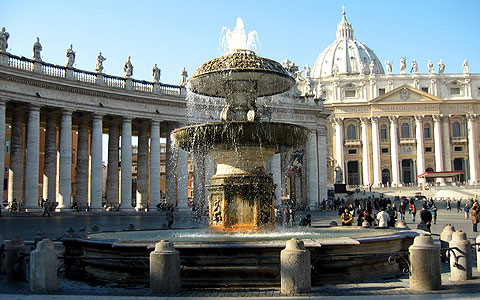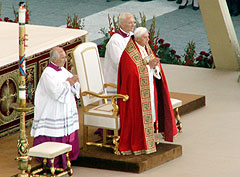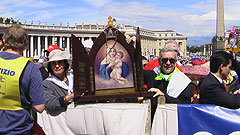Mary, the woman who listens to the Word of God
Meeting of the Holy Father with the clergy of Rome
 |
Roma, San Pedro: una vez por año, el Santo Padre invita a los sacerdotes de la diócesis de Roma Rome, St. Peter’s: Once a year, the Holy Father invites the priests of the diocese of Rome Rom, St. Peter: einmal im Jahr lädt der Papst die Priester der Diözese Rom ein |
 |
|
Benedicto XVI (encuentro con los Movimientos) Bendict XVI (meeting with the movements) Benedikt XVI. (hier bei der Begegnung mit den Bewegungen) |
|
 |
|
El P. Guillermo Mario con la Auxiliar Internacional en San Pedro Fr. Guillermo Mario with the International Auxiliary at St. Peter’s P. Guillermo Mario Cassone mit der Internationalen Auxiliar auf dem Petersplatz Fotos: Fischer/Santos © 2009 |
|
ROME. Following a Lenten tradition, Benedict XVI met Feb.26 with parish priests and clergy of the Diocese of Rome for a question-and-answer session. One of the priests who asked a question, was Fr. Guillermo Mario Cassone, Schoenstatt Father from Argentina, who works in the parish assigned to the Fathers.
Fr. Guillermo Mario Cassone took the synod on the Word of God as a starting point, expressing his wish to improve the relationship between the Word of God and Marian devotion.
His presentation and question was: Holy Father, I am Father William M. Cassone, of the Community of Schoenstatt Fathers in Rome, parish vicar in the parish of Italy's patron saints, St. Francis and St. Catherine, in Trastevere.
Following the synod on the Word of God, reflecting on Proposition 55, "Maria Mater Dei et Mater Fidei," I wonder how we could improve the relationship between the Word of God and Marian devotion, be it in the priestly spiritual life or in pastoral action. Two images are helpful to me: the Annunciation for listening and the Visitation for the proclamation. I would like to ask you, Your Holiness, to enlighten us with your teaching on this subject. Thank you for this gift."
Benedict XVI answered:
I think that you yourself have answered your question. Mary is really the woman who listens: We see it in the meeting with the angel, and we see it again in all the scenes of her life, from the wedding at Cana to the cross and to the day of Pentecost, when she was in the midst of the Apostles precisely to receive the Spirit. She is the symbol of openness, of the Church that awaits the coming of the Holy Spirit.
Mary, the woman who listens to the Word
At the moment of the proclamation we can already have an attitude of listening -- a true listening, a listening that is internalized, which does not simply say yes, but which assimilates the Word, takes the Word, and then follows with true obedience, as if it were an internalized Word, that is, converted into a Word in me and for me, almost the form of my life. This seems very beautiful to me: to see this active listening, a listening that attracts the Word so that it enters and becomes Word in me, reflecting on it and accepting it in the depth of my heart. Thus the Word becomes incarnate.
We see the same in the Magnificat. We know that it is a fabric made up of words of the Old Testament. We see that Mary is really a woman who listens, who knew the Scriptures in her heart. She did not just know some texts, but was so identified with the Word that the words of the Old Testament became synthesized, a song in her heart and on her lips. We see that her life was really penetrated by the Word, she had entered the Word, had assimilated it and it had become life in her, transforming itself again in a Word of praise and proclamation of the greatness of God.
Referring to Mary, I think that St. Luke says at least three times, perhaps four times, that she assimilated and kept the Word in her heart. For the Fathers, she was the model of the Church, the model of the believer that keeps the Word, bears the Word in himself; who does not just read it or interpret it with his intelligence in order to know what happened at that time, what the philological problems are. All this is interesting and important, but it is more important to listen to the Word that is kept and that becomes Word in me, life and the Lord's presence in me. That is why I find the connection important between Mariology and theology of the Word, of which the synodal fathers spoke and of which we shall speak in the post-synodal document.
It is obvious: The Virgin is the word of listening, silent word, but also word of praise, of proclamation, because in listening, the Word again becomes flesh and thus becomes the presence of God's greatness.